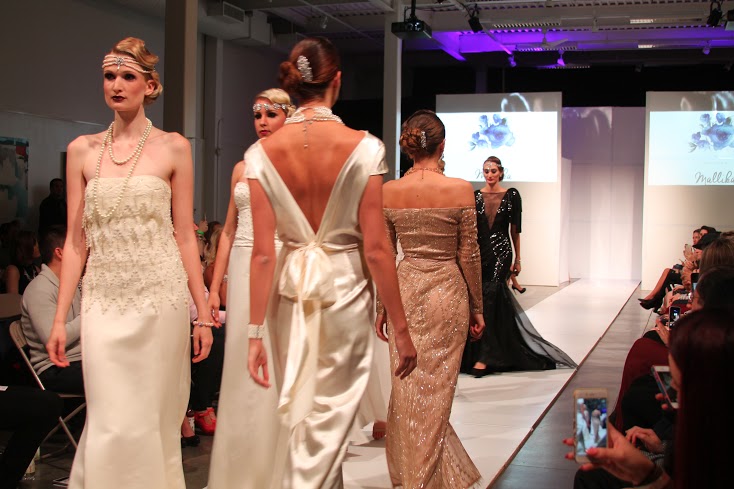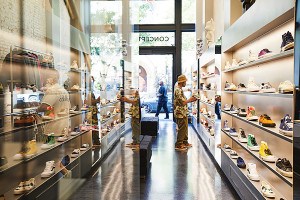Emerging Trends Fashion Show Arrives at Boston Fashion Week

Young designers showcased their new collections at Boston Fashion Week’s “Emerging Trends” show last week. / Photo by Summer Lin
It wasn’t just Boston Fashion Week’s “Emerging Trends” show we arrived to late last week, but a mecca of creative visuals and global talent as as seven of the industry’s brightest emerging international designers all gathered under one roof. The traveling Emerging Trends show has been presented all over the world from New York City to London–and made it’s 8th annual stop in Boston this past Friday. Held at Artists for Humanity Epicenter at 100 W 2nd Street, and featuring designers from style hubs like France and China, it was a night of decadent wedding gowns, exotic prints, and innovative futuristic design.

Glamorous evening wear by Mallika Hetrakul made it’s way down the catwalk at Boston Fashion Week / Photo by Summer Lin
Mallika Hetrakul’s take on old Hollywood glamour, merged with modern sensibilities, was a relic of Art Deco designs from the twenties and thirties. With wispy flapper-esque silhouettes and pearl headpieces plundered from the Jazz Age, glowing duchess satin, lace, bead embellishments, and soft crepe viscose all came together in loose-fitting, yet still body consciousness wedding gowns. The Australian-based designer’s tulle-lined and delicate drop-waist gowns were made to be timeless—”You can take it out in ten years and wear it out again,” she said.

A nature-inspired collection by Kanjana Amato featured a showstopping orange velvet frock. / Photo by Summer Lin
Luscious and flowing silk, inspired by butterflies, fish, and flowers for springtime, dominated Kanjana Amato’s Ready-to-Wear “Ocean’s Tale” collection. Rich silk gowns replete with flowing hemlines were offset with pleated crepe, Grecian one-shoulder designs, loose mesh, and beaded embellishments. Our favorite? A bright orange velvet gown with a plunging neckline, an open back, and a draped silhouette, paired with hi-top sneakers to balance off the sultry look.
California College of Arts graduate Hao Dong wanted to use fashion “as a stage for art.” Her “Hao R U” collection features pop art designs crafted from neoprene and fur paired with oversized, chunky silhouettes, bright neon shades of orange, blue, and yellow, and hand-painted graphics of the designer’s face in a grand statement about mass label appeal and individualism. Layering a blue fur vest over billowing satin pants, Dong certainly has an eye for the unconventional. “Most people design feminine pieces that show off your curves and I wanted to show the other side,” she said.

Designer Mariela Skenderova featured easy-to-wear silhouettes and warm earth tones. / Photo by Summer Lin
Mangoshee’s machine-molded galoshes, crafted from PVC and silicone, were meticulously hand-decorated with leather and wood embellishments. Inspired by natural elements of the forest, Bulgarian designer Mariela Skenderova utilized warm, earth tones to craft shoes that were traditionally worn by Bulgarian women while working in the fields into a fashion statement for the open-minded individual.
Anyone looking for exotic prints and bold pops of color should look no further than Modern Vintage Gate 26’s collection. Designer Andy Jacques was inspired by his recent trip to Qatar and Mumbai, incorporating Middle Eastern-inspired prints into his collection of ruched dresses, high-neck blouses, and applique skirts. Soft silhouettes, rich colors, animal print, and metallic sequins gave the designs a diverse flair, tailored specifically for the woman who is a “jetsetter on a whim.”

Designer Eszter Bodi boasted versatile pieces that transformed from hoods to vests right on the runway. / Photo by Summer Lin
Hungarian designer Eszter Bodi’s “BodiEs” collection was inspired by the Barbie dolls and scrunchies of her youth, designing practical use, waterproof scarves that could be transformed into a hood one minute and a vest the next. Bodi played on the theme of Barbie dolls as models donned blue and pink silk scarves before changing into skirts and shawls halfway through the show, demonstrating the accessory’s range of multifunctionality.
Avant-garde would be the understatement of the year for the student-designed NUVU Studio Group. Focusing on the limits of human experience and future realities, designers engineered a LED light-up laser acrylic “emotion mask” with hand controls hooked up through manual wiring, allowing the mask to change color depending on the model’s hand movements. A dress replete with red spikes represented the extension of the body and a mobility tool for the visually impaired. Designed as a companion to the “emotion mask,” a dress with slats made from wood and mylar evoked the sense of “fight or flight” response, symbolizing the body’s physical reaction to an emotional stimulant.





